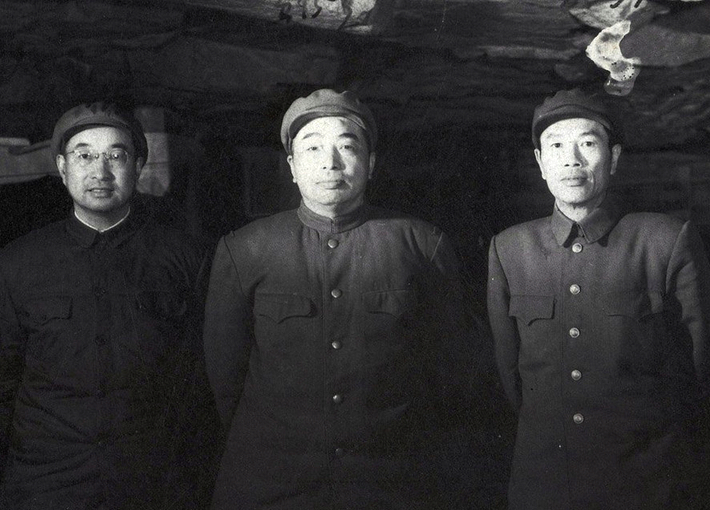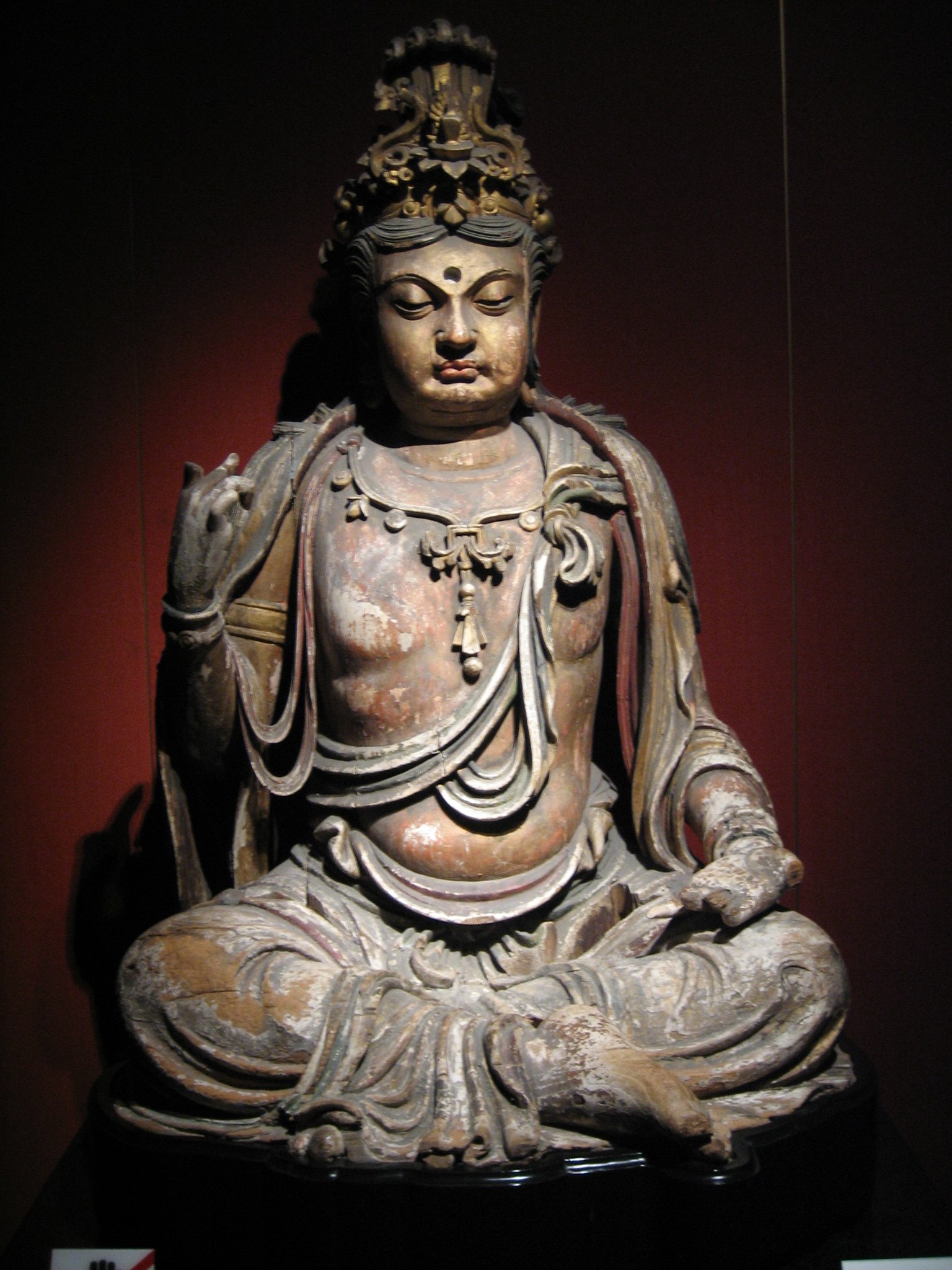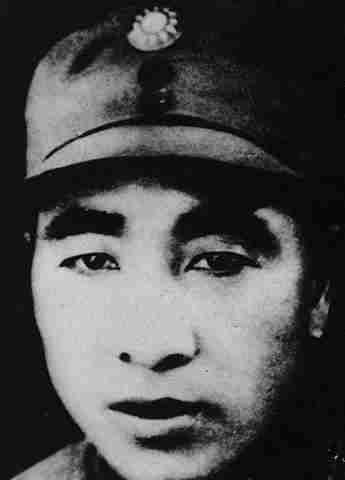|
Gao Gang
Gao Gang ( zh, s=高岗, w=Kao Kang; 1905 – August 1954) was a Chinese Communist Party (CCP) leader during the Chinese Civil War and the early years of the People's Republic of China (PRC) before he became the victim of the first major purge within the party since before 1949. The events surrounding Gao's purge, the so-called "Gao Gang Affair", are still the subject of debate: a limited amount of research has been done on the topic, partly because of the relatively small amount of information available. Born in rural Shaanxi province in 1905, Gao Gang joined the party in 1926 and led a revolutionary guerrilla base there during the Chinese Civil War. He was of peasant background with a low level of education: he is said to have not been very literate. Among his colleagues in the party, he gained a reputation as having great confidence and ambition, as well as of being a womanizer. Trusted by Mao Zedong, Gao was dramatically promoted in the final years of the civil war to become ... [...More Info...] [...Related Items...] OR: [Wikipedia] [Google] [Baidu] |
Gao (surname)
Gao () is an East Asian surname of Chinese origin that can be literally translated as "high" or "tall". There are approximately 17 million living people with this surname. Some places, such as Taiwan, usually romanise this family name into "Kao". In Hong Kong, it is romanized to "Ko". In Macau, it is romanized to "Kou". In English, it is romanized to "Kauh". In 2019 it was the 19th most common surname in Mainland China. The Korean surname, "Ko (Korean surname), Ko" or "Koh", is derived from and written with the same Chinese character (高). Romanisation and pronunciation Origin According to ''Lüshi Chunqiu'', the earliest figure with the Gao surname was Gao Yuan (高元) who created dwellings in antiquity. Zhuanxu, the grandson of the Yellow Emperor, was also known as Gao Yang (高陽). Another origin of Gao is the Jiang (surname 姜), Jiang (姜) surname. According to the Song dynasty encyclopedia ''Tongzhi (encyclopedia), Tongzhi'', an early ancestor was Gao Xi (高傒) w ... [...More Info...] [...Related Items...] OR: [Wikipedia] [Google] [Baidu] |
Liu Zhidan
Liu Zhidan (4 October 1903 – 14 April 1936), also known as Liu Chih-tan, was a Chinese military commander and Communist leader, who founded the Shaanxi-Gansu-Ningxia Base Area in north-west China, which became the Yan'an Soviet. Early life Liu Zhidan was born in 1902/3 into a literati family in Bao'an, since renamed Zhidan County in his honour, in northern Shaanxi Province.(Chinese傅国涌 "刘志丹的悲壮人生" 炎黄春秋杂志 2000年第11期 He was given the name Jinggui (, ''Jǐngguì''), which he later changed to Zhidan. Liu attended the first primary school in the county and was a member of the first graduating class and gained acceptance to Yulin Middle School. He joined the Communist Party in 1925. In Yulin, he was influenced by the May Fourth Movement and joined the Chinese Communist Youth League and the Society for Mutual Progress, a progressive civic organization. After the May 30th Movement, he and fellow students traveled to Shanxi, Beijing and Shan ... [...More Info...] [...Related Items...] OR: [Wikipedia] [Google] [Baidu] |
People's Volunteer Army
The People's Volunteer Army (PVA), officially the Chinese People's Volunteers (CPV), was the armed expeditionary forces China in the Korean War, deployed by the History of the People's Republic of China (1949–1976), People's Republic of China during the Korean War. Although all units in the PVA were actually transferred from the People's Liberation Army (PLA) under the orders of Chairman of the Chinese Communist Party, Chairman Mao Zedong, the PVA was separately constituted in order to prevent an official war with the United States. The PVA entered Korea on 19 October 1950 and completely withdrew by October 1958. The nominal commander and political commissar of the PVA was Peng Dehuai before the Korean Armistice Agreement, ceasefire agreement in 1953, although both Chen Geng and Deng Hua served as the acting commander and commissar after April 1952 following Peng's illness. The initial (25 October – 5 November 1950) units in the PVA included 38th, 39th, 40th, 42nd, 50th, 66 ... [...More Info...] [...Related Items...] OR: [Wikipedia] [Google] [Baidu] |
North Korea
North Korea, officially the Democratic People's Republic of Korea (DPRK), is a country in East Asia. It constitutes the northern half of the Korea, Korean Peninsula and borders China and Russia to the north at the Yalu River, Yalu (Amnok) and Tumen River, Tumen rivers, and South Korea to the south at the Korean Demilitarized Zone, Korean Demilitarized Zone (DMZ). The country's western border is formed by the Yellow Sea, while its eastern border is defined by the Sea of Japan. North Korea, like South Korea, claims to be the sole legitimate government of the entire peninsula and List of islands of North Korea, adjacent islands. Pyongyang is the capital and largest city. The Korean Peninsula was first inhabited as early as the Lower Paleolithic period. Its Gojoseon, first kingdom was noted in Chinese records in the early 7th century BCE. Following the unification of the Three Kingdoms of Korea into Unified Silla, Silla and Balhae in the late 7th century, Korea was ruled by the G ... [...More Info...] [...Related Items...] OR: [Wikipedia] [Google] [Baidu] |
Korean War
The Korean War (25 June 1950 – 27 July 1953) was an armed conflict on the Korean Peninsula fought between North Korea (Democratic People's Republic of Korea; DPRK) and South Korea (Republic of Korea; ROK) and their allies. North Korea was supported by China and the Soviet Union, while South Korea was supported by the United Nations Command (UNC) led by the United States. The conflict was one of the first major proxy wars of the Cold War. Fighting ended in 1953 with an armistice but no peace treaty, leading to the ongoing Korean conflict. After the end of World War II in 1945, Korea, which had been a Korea under Japanese rule, Japanese colony for 35 years, was Division of Korea, divided by the Soviet Union and the United States into two occupation zones at the 38th parallel north, 38th parallel, with plans for a future independent state. Due to political disagreements and influence from their backers, the zones formed their governments in 1948. North Korea was led by Kim Il S ... [...More Info...] [...Related Items...] OR: [Wikipedia] [Google] [Baidu] |
Soviet-type Economic Planning
Soviet-type economic planning (STP) is the specific model of Planned economy#Central planning, centralized planning employed by Marxism–Leninism, Marxist–Leninist socialist states modeled on the economy of the Soviet Union. The post-''perestroika'' analysis of the system of the Soviet economic planning describes it as the administrative-command system due to the ''de facto'' priority of highly centralized management over planning. An example of analytical approach to several stages of the Soviet political-economic model can be found in the works of Soviet economist Lev Gatovsky. Characteristics Institutions The major institutions of Soviet-type planning in the Soviet Union (USSR) included a planning agency (Gosplan), an organization for allocating state supplies among the various organizations and enterprises in the economy (Gossnab) and enterprises which were engaged in the production and delivery of goods and services in the economy. Enterprises comprised production a ... [...More Info...] [...Related Items...] OR: [Wikipedia] [Google] [Baidu] |
Soviet Union
The Union of Soviet Socialist Republics. (USSR), commonly known as the Soviet Union, was a List of former transcontinental countries#Since 1700, transcontinental country that spanned much of Eurasia from 1922 until Dissolution of the Soviet Union, it dissolved in 1991. During its existence, it was the list of countries and dependencies by area, largest country by area, extending across Time in Russia, eleven time zones and sharing Geography of the Soviet Union#Borders and neighbors, borders with twelve countries, and the List of countries and dependencies by population, third-most populous country. An overall successor to the Russian Empire, it was nominally organized as a federal union of Republics of the Soviet Union, national republics, the largest and most populous of which was the Russian SFSR. In practice, Government of the Soviet Union, its government and Economy of the Soviet Union, economy were Soviet-type economic planning, highly centralized. As a one-party state go ... [...More Info...] [...Related Items...] OR: [Wikipedia] [Google] [Baidu] |
State Council Of The People's Republic Of China
The State Council of the People's Republic of China, also known as the Central People's Government, is the chief administrative authority and national cabinet. It is constitutionally the highest administrative organ of the country and the executive organ of the National People's Congress, the highest organ of state power. It is composed of a premier, vice-premiers, state councilors, ministers, chairpersons of commissions, an auditor-general, the governor of the People's Bank of China, and a secretary-general. The premier of the State Council is responsible for the State Council and exercises overall leadership of its work. The secretary-general of the State Council, under the leadership of the premier, is responsible for handling the daily work of the State Council and heads the General Office of the State Council. The executive meeting of the State Council, consisting of the premier, vice-premiers, state councilors, and the secretary-general, is held two to three times a ... [...More Info...] [...Related Items...] OR: [Wikipedia] [Google] [Baidu] |
Maurice Meisner
Maurice Jerome Meisner (November 17, 1931 – January 23, 2012) was an American sinologist and professor at the University of Wisconsin–Madison. He studied the Chinese Communist Revolution and the People's Republic and held a strong interest in socialist ideology, Marxism, and Maoism in particular. He authored a number of books including '' Mao's China: A History of the People's Republic'' which became a standard academic text for scholars in the field. Early years Maurice Meisner was born in Detroit, Michigan in 1931 to Isadore Meisner and Leah Pergament, Jewish immigrants from Eastern Europe. He grew up during Great Depression and World War II, but reached adulthood during the post-war boom in which Detroit had become a center of culture and industry. He remained in Detroit for his undergraduate studies, enrolling at Wayne State University. An outstanding student, Meisner was admitted to a graduate program there after only two years of college. He had two marriages each las ... [...More Info...] [...Related Items...] OR: [Wikipedia] [Google] [Baidu] |
Northeast China
Northeast China () is a geographical region of China, consisting officially of three provinces Liaoning, Jilin and Heilongjiang. The heartland of the region is the Northeast China Plain, the largest plain in China with an area of over . The region is separated from the Russian Far East to the north and east by the Amur, Argun and Ussuri Rivers; from North Korea to the south by the Yalu and Tumen Rivers; and from the neighboring North China to the west by the Greater Khingan Range and Yan Mountains. It is also bounded by the Bohai Bay and Yellow Sea to the southwest, about away from East China's Jiaodong Peninsula across the Bohai Strait, due to be connected via a proposed undersea tunnel. The four prefectures of Inner Mongolia (which is part of North China) east of the Greater Khingan, i.e. Chifeng, Tongliao, Hinggan and Hulunbuir, are sometimes also considered broader parts of Northeast China, and together with the aforementioned three provinces formed what was h ... [...More Info...] [...Related Items...] OR: [Wikipedia] [Google] [Baidu] |
Lin Biao
Lin Biao ( zh, 林彪; 5 December 1907 – 13 September 1971) was a Chinese politician and Marshal of the People's Republic of China who was pivotal in the Chinese Communist Party, Communist Chinese Communist Revolution, victory during the Chinese Civil War, especially in Northeast China from 1946 to 1949. Lin was the general who commanded the decisive Liaoshen campaign, Liaoshen and Pingjin campaigns, in which he co-led the Manchurian Field Army to victory and led the People's Liberation Army into Beijing. He crossed the Yangtze, Yangtze River in 1949, decisively defeated the Kuomintang and took control of the coastal provinces in Southeast China. He ranked third among the Yuan shuai#People's Republic of China, Ten Marshals. Zhu De and Peng Dehuai were considered senior to Lin, and Lin ranked directly ahead of He Long and Liu Bocheng. Lin abstained from taking an active role in politics after the war ceased in 1949. He led a section of the government's civil bureaucracy as one o ... [...More Info...] [...Related Items...] OR: [Wikipedia] [Google] [Baidu] |
Politburo Of The Chinese Communist Party
The Politburo of the Chinese Communist Party, officially the Political Bureau of the Central Committee of the Communist Party of China, is the executive committee of the Central Committee of the Chinese Communist Party. Currently, the bureau is a group of 24 top officials who oversee the party and central government. The politburo is headed by the general secretary. Unlike the politburos of other communist parties, the CCP Politburo subdelegates many of its powers to the smaller Politburo Standing Committee. The Politburo is elected by the Central Committee. In practice, however, scholars of Chinese elite politics believe that the Politburo is a self-perpetuating body, with new members of both the Politburo and its Standing Committee chosen through a series of deliberations by current Politburo members and retired Politburo Standing Committee members. The current and former Politburo members conduct a series of informal straw polls to determine the group's level of support f ... [...More Info...] [...Related Items...] OR: [Wikipedia] [Google] [Baidu] |




